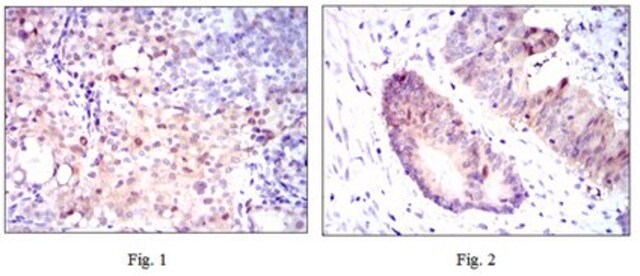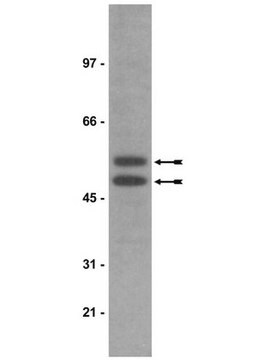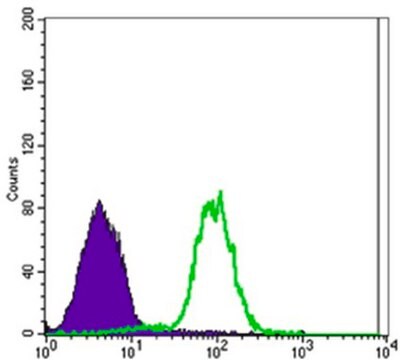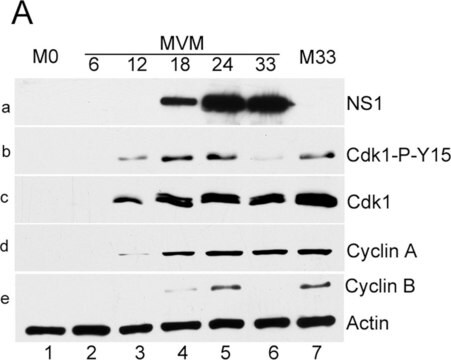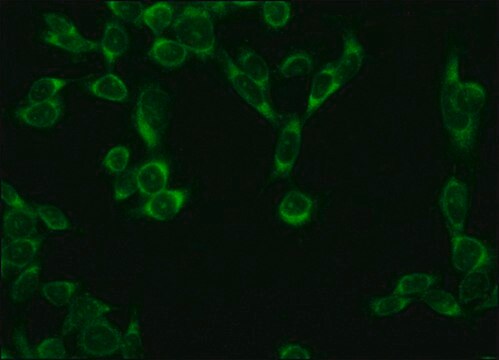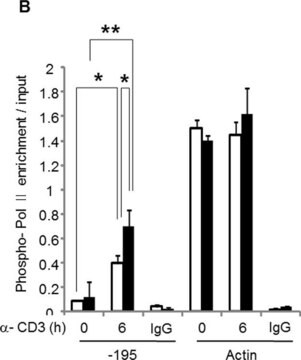MABF957
Anti-CLEC-2 Antibody, clone AYP1
clone AYP1, from mouse
Sinónimos:
C-type lectin domain family 1 member B, C-type lectin-like receptor 2, CLEC-2
About This Item
Productos recomendados
origen biológico
mouse
Nivel de calidad
forma del anticuerpo
purified immunoglobulin
tipo de anticuerpo
primary antibodies
clon
AYP1, monoclonal
reactividad de especies
human
técnicas
flow cytometry: suitable
isotipo
IgG1κ
Nº de acceso NCBI
Nº de acceso UniProt
Condiciones de envío
ambient
modificación del objetivo postraduccional
unmodified
Información sobre el gen
human ... CLEC1B(51266)
Descripción general
Especificidad
Inmunógeno
Aplicación
Flow Cytometry Analysis: A representative lot (pre-conjugated with Alexa Fluor™ 488) detected CLEC-2/CLEC1B expression on the surface of platelets and CD41-positive microparticles in platelet-rich plasma (PRP), but not on monocytes, neutrophils, dendritic cells, B- or T-cells (Gitz, E., et al. (2014). Blood. 124(14):2262-2270).
Function Assay: Clone AYP1 Fab fragment (2.5 µg/mL) cross-linked with anti-mouse Fab-specific F(ab)2 fragments, but not AYP1 Fab or anti-mouse F(ab)2 alone, induced surface P-selectin expression and the aggregation of washed human platelets (Gitz, E., et al. (2014). Blood. 124(14):2262-2270).
Immunoprecipitation Analysis: A representative lot immunoprecipitated CLEC-2/CLEC1B from human platelet lysates. Rhodocytin stimulation prior to cell lysis and IP induced CLEC-2/CLEC1B tyrosine phosphorylation (Gitz, E., et al. (2014). Blood. 124(14):2262-2270).
Calidad
Flow Cytometry Analysis: 0.2 µL of this antibody detected CLEC-2/CLEC1B on the surface of human platelets.
Descripción de destino
Forma física
Otras notas
Información legal
¿No encuentra el producto adecuado?
Pruebe nuestro Herramienta de selección de productos.
Código de clase de almacenamiento
12 - Non Combustible Liquids
Clase de riesgo para el agua (WGK)
WGK 2
Punto de inflamabilidad (°F)
Not applicable
Punto de inflamabilidad (°C)
Not applicable
Certificados de análisis (COA)
Busque Certificados de análisis (COA) introduciendo el número de lote del producto. Los números de lote se encuentran en la etiqueta del producto después de las palabras «Lot» o «Batch»
¿Ya tiene este producto?
Encuentre la documentación para los productos que ha comprado recientemente en la Biblioteca de documentos.
Nuestro equipo de científicos tiene experiencia en todas las áreas de investigación: Ciencias de la vida, Ciencia de los materiales, Síntesis química, Cromatografía, Analítica y muchas otras.
Póngase en contacto con el Servicio técnico

